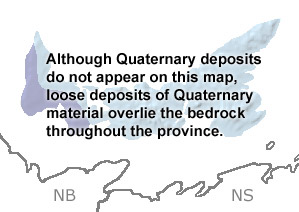

The Quaternary in Prince Edward Island, Canada |
|||||||||||||||||||||||||||||||||||||||||||||||||||||||||||
|
|||||||||||||||||||||||||||||||||||||||||||||||||||||||||||
Paleontology and geologyThe effects of Pleistocene glaciations shape much of the topography of modern Prince Edward Island. Glacial debris and marks gouged into the bedrock can be found in many places on PEI, recording several advances and retreats of glaciers over the area. There are fossils, such as foraminifera, present in some silty marine deposits, indicating times of relatively high sea level during the Pleistocene in this region. Other fossils found in Pleistocene deposits on the island include diatoms, pollen grains, plant debris, and spores. Studies of the continental shelf below the Northumberland Strait (between PEI and neighboring New Brunswick and Nova Scotia) have revealed that the island was connected to the mainland for a time around 11,000 years ago. As the last glacial ice retreated, relative sea level changes submerged this former land bridge. Stone tools made from a variety of geological sources from around the region appear to indicate that early human cultures traveled and traded through this region during the last ice ages. |
|||||||||||||||||||||||||||||||||||||||||||||||||||||||||||
|
|
|||||||||||||||||||||||||||||||||||||||||||||||||||||||||||
|
site tour |
about the site |
site map |
site credits |
page credits |
help |
FAQs |
contact |
||

